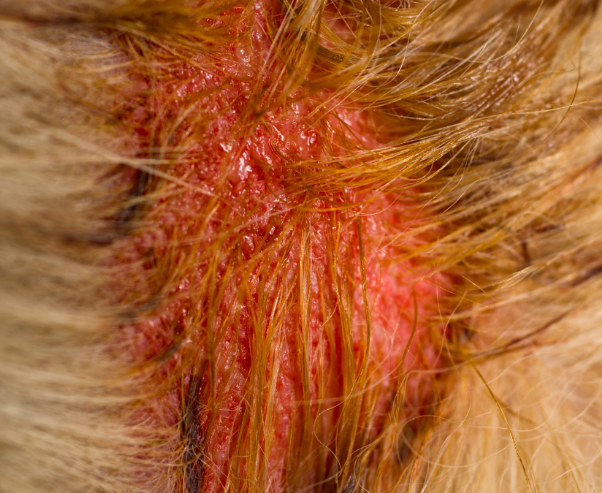Acute Moist Dermatitis: “Hot Spots”
What is Acute Moist Dermatitis (Hot Spots)?
Acute moist dermatitis, commonly known as a "hot spot," is a local skin irritation that causes intense itching and discomfort, often resulting from self-inflicted trauma. It typically appears as an inflamed, moist area of skin, and if left untreated, it can worsen quickly.
Causes of Hot Spots
Hot spots are most commonly caused by a variety of factors, including:
Flea allergic dermatitis
Ear infections
Other parasites (e.g., skin mites)
Environmental or food allergies
Anal sac issues
Contact dermatitis (exposure to irritants)
Hot spots are more frequent in hot, humid weather and are particularly common in breeds with dense undercoats, such as:
Golden Retrievers
Labrador Retrievers
St. Bernards
German Shepherds
However, any breed and age of dog can develop hot spots.
Clinical Signs
Pets with hot spots may exhibit the following symptoms:
Intense itching and possible pain
Hair loss and redness in the affected area
Moist skin surface
Common locations for hot spots include the tail base, outer thighs, neck, and face.
Diagnosis
Diagnosis of hot spots is based on the appearance of the lesion, rapid onset, and extreme itchiness. The location of the hot spot can often help determine the underlying cause (e.g., flea allergy, ear infection, etc.).
Treatment: Basic Process
Identify and address the underlying cause: Treating the root cause (such as fleas, ear infections, or allergies) is essential to prevent recurrence.
Clip hair around the affected area to allow air circulation and promote healing.
Clean the area gently with a diluted antimicrobial solution (such as diluted iodine).
Apply topical medications to help dry the area and reduce inflammation.
Systemic steroids may be prescribed to break the itch cycle, and antibiotics may be needed if there is a secondary infection.
Elizabethan collar: This may be recommended to prevent further trauma from licking or scratching.
What Can You Do at Home?
While hot spots are often infected and uncomfortable, making a vet visit important for full resolution, there are some intermediate steps you can take at home to help your pet feel more comfortable:
Clean the area: Dilute Povidone iodine or Betadine (from a human pharmacy) with water to a "light tea" color. Use this solution to gently clean the hot spot and allow it to dry well.
Apply antimicrobial spray: Use Vetericyn (available from PetSmart, Petco, Amazon, etc.), applying it to the affected area every 8 hours (three times daily).
Prevent further trauma: Consider obtaining an Elizabethan collar (E-collar) to stop your pet from licking or scratching the area, which can worsen the condition.
These at-home measures can help with comfort and provide temporary relief until a veterinarian can assess and treat the hot spot properly.
Priority / Urgency / Emergency
*aURGENCY*
Hot spots can be extremely uncomfortable and painful, requiring rapid care. They are considered an urgent priority, and veterinary care should not be delayed more than 24 hours after detection. If your regular vet is unavailable, an urgent care vet can also assist in managing the condition.
Follow-Up Care
To prevent future hot spots, it’s important to:
Regularly groom your pet to remove excess hair and debris.
Maintain good hygiene, especially in humid conditions.
Keep up with flea control, as flea allergies can trigger hot spots.
Clean ears regularly if ear infections are a contributing factor.
Follow-up appointments with your veterinarian may be necessary to ensure the infection has fully healed and to address any underlying causes.
Prognosis
With prompt treatment and addressing any underlying causes, the prognosis is generally good. However, if left untreated or if the underlying issue persists (such as untreated allergies or flea infestations), hot spots can recur or become chronic.



